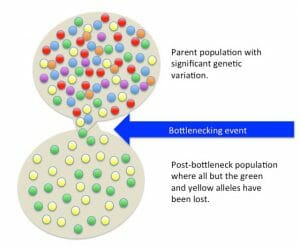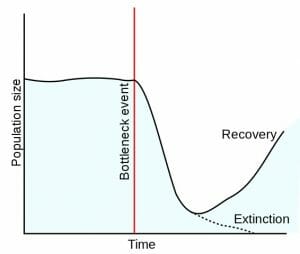Population Definition
A population is the number of organisms of the same species that live in a particular geographic area at the same time, with the capability of interbreeding.
For interbreeding to occur, individuals must be able to mate with any other member of a population and produce fertile offspring. However, populations contain genetic variation within themselves, and not all individuals are equally able to survive and reproduce.
Populations can occur on various different scales. A local population can be confined to a spatially small area, i.e., the fish in one pond. However, this locality can operate on a regional, countrywide, island or continental scale; it may even make up the entire species. If individuals of local populations are able to disperse between other local populations, this is called a metapopulation.
Population biology is the study of population characteristics and the factors that affect their size and distribution. The characteristics which are studied include the migratory patterns, the population density, the demographics (the birth and death rates, sex ratio and age distribution), the population genetics, the life history traits and the group dynamics (the interactions within and between populations). Population ecology is the study of how these populations interact with the environment.
Most populations are not stable, fluctuating in size over time (the letter ‘N’ often denotes the number of individuals in a population). The fluctuations are usually in response to changes in the abiotic and biotic factors, which act as limiting factors against indefinite exponential growth of populations. For example, when food resources are plentiful and environmental conditions are favorable, populations may grow. Conversely, when predation is strong, populations may become depleted.
The characteristics of the population can influence how it is affected by certain factors. The effects that density-dependent factors may have on a population are determined by its size; for example, a larger, denser population will be decimated more quickly by the spread of disease than a widely dispersed population. Life history traits, such as the maturation rate and life span, can affect the rate of growth of a population; if individuals mature later, the population will grow more slowly than if they mature relatively young.
Due to the genetic variation within populations, those that are larger are usually more resilient to stochastic changes in their environment or demography. This is because there is a higher chance that a genetic mutation within the gene pool is better adapted to survive in the new situation. If an extreme event occurs, in which a large number of individuals within the population are unable to survive, the remaining individuals with the favored genes will reproduce, thereby increasing the frequency of these genes in the population by genetic drift. This is called a population bottleneck.

Although the individuals who survived the bottleneck are adapted to the new conditions, there is not always a good rate of long-term success for the population. Genetic diversity within the new population is low, and only increases very slowly as mutations occur in each successive generation. This means that the new population is highly vulnerable to further changes to the environment or availability of resources, as well as suffering the consequences of inbreeding such as disease and deformity in offspring. If a bottleneck results in too few individuals (under the minimum viable population size(MVP), there is a considerable risk of extinction after a few generations.

Examples of Populations
African Elephants
There are two traditionally recognized species of elephant, African elephants (Loxodonta Africana) and Asian Elephants (Elephas maximus), although recent research has divided the African elephants into two species: the African bush elephants (Loxodonta africana) and the African forest elephants (Loxodonta cyclotis).
Populations of African elephants are believed to have existed on a continental-wide scale, numbering up to 5 million individuals in the early 1900s. However, due to habitat fragmentation and poaching for their tusks, elephant numbers have suffered severe declines. There are now believed to be around 400,000 remaining African elephants.
Elephant group structure is formed of family units of around 10 individuals, although when elephant families come into contact, they may bond to form larger groups – called ‘herds’ – of up to 100. Each of these herds forms a local population. However, any individual from each species could reproduce with another species member, so the full population of each African species includes all the individuals on the continent.
Pond Populations
Within a habitat there can be many different populations; a small-scale example is a lake. A lake may provide a habitat for birds, fish, insects, amphibians and mammals such as otters or rats. Although each species is provided with resources from the lake, their populations are likely to rely on the habitat in unique ways. For fish, land presents an impenetrable barrier for dispersal. Without any way of leaving, an entire population of trout may exist solely within the lake and nowhere else.
Amphibians such as toads may spawn in the lake, and use several nearby lakes within a valley for feeding. However, because they cannot get across mountains, their local population is restricted to the inside of the valley. If environmental conditions within the valley differ from other surrounding valleys, and the toads are isolated from other populations of the same species for long enough, the behavior or morphology of the toad may change sufficiently enough so that it cannot mate with toads outside of the valley. This isolation would drive the process of speciation and thus the formation of new species.
Migrating birds may visit the lake seasonally in order to winter; for part of the year, these birds form a local population. When the birds return from their wintering grounds, they meet with other populations of the same species so that they can breed in larger numbers. It is common for birds of different ages or sexes to migrate at different times or distances, so the population sizes depend on the group demography.
Salmon
Many species of Salmon are anadromous, which means they are born in fresh water before migrating to the ocean to feed and mature, and return to fresh water to breed.
Salmon tend to return to the same river that they were born in, in order to themselves spawn. Because of this strong desire to ‘home’, salmon usually do not stray far away from their native spawning site, although the dispersal distance depends largely on the particular species.
Because most spawning sites are separated by land or deep water, each group of salmon that are born in a certain spawning site makes up the local population within that site; although the conditions within the routes available for dispersal to other sites are not impossible for the salmon to withstand, they are rarely found to move between sites.
During their time spent at sea, salmon come into contact with salmon from other local populations, even very distant ones. Although there are no barriers to mating between local populations of the same species, the tendency of salmon to return to their natal river greatly reduces gene flow between them. Nonetheless, some individuals do stray from the expected route, either by choice or in error, resulting in some gene flow between populations.
Due to their life history cycle, salmon can be categorized within the metapopulation structure.
Related Biology Terms
- Community – A group consisting of various species, which interact with each other directly or passively, in a common location.
- Species – A group of physically similar individuals, which are capable of reproducing with the outcome of fertile offspring.
- Gene pool – The set of genes present within a population or species.
- Speciation – The formation of new, distinct species.
Quiz
1. Which of the following scenarios best fits the definition of a population?
A. Five species of frog living in a swamp.
B. All of the sharks swimming off the west coast of Australia.
C. All the individual mountain gorillas living in the dense forest of four national parks in Africa.
D. The birds, bats and monkeys, which live in the rainforest of Ecuador.
2. A population bottleneck occurs when:
A. The numbers of individuals in a group becomes too high.
B. An event causes a significant loss of individuals in a population.
C. Species migrate away from their native population.
D. Two populations merge together to form a new population.
3. Small populations are more vulnerable than large ones because:
A. They are more likely to be predated on.
B. They are vulnerable to change because they have a smaller gene pool.
C. They cannot keep each other warm.
